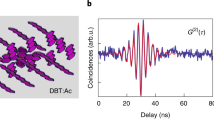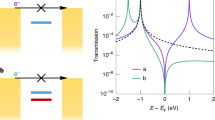Abstract
The transistor is one of the most influential inventions of modern times and is ubiquitous in present-day technologies. In the continuing development of increasingly powerful computers as well as alternative technologies based on the prospects of quantum information processing, switching and amplification functionalities are being sought in ultrasmall objects, such as nanotubes, molecules or atoms1,2,3,4,5,6,7,8,9. Among the possible choices of signal carriers, photons are particularly attractive because of their robustness against decoherence, but their control at the nanometre scale poses a significant challenge as conventional nonlinear materials become ineffective. To remedy this shortcoming, resonances in optical emitters can be exploited, and atomic ensembles have been successfully used to mediate weak light beams7. However, single-emitter manipulation of photonic signals has remained elusive and has only been studied in high-finesse microcavities10,11,12,13 or waveguides8,14. Here we demonstrate that a single dye molecule can operate as an optical transistor and coherently attenuate or amplify a tightly focused laser beam, depending on the power of a second ‘gating’ beam that controls the degree of population inversion. Such a quantum optical transistor has also the potential for manipulating non-classical light fields down to the single-photon level. We discuss some of the hurdles along the road towards practical implementations, and their possible solutions.
This is a preview of subscription content, access via your institution
Access options
Subscribe to this journal
Receive 51 print issues and online access
$199.00 per year
only $3.90 per issue
Buy this article
- Purchase on Springer Link
- Instant access to full article PDF
Prices may be subject to local taxes which are calculated during checkout




Similar content being viewed by others
References
Tans, S. J., Verschueren, A. R. M. & Dekker, C. Room-temperature transistor based on a single carbon nanotube. Nature 393, 49–52 (1998)
Park, J. et al. Coulomb blockade and the Kondo effect in single-atom transistors. Nature 417, 722–725 (2002)
Liang, W., Shores, M. P., Bockrath, M., Long, J. R. & Park, H. Kondo resonance in a single-molecule transistor. Nature 417, 725–729 (2002)
Davidovich, L., Maali, A., Brune, M., Raimond, J. M. & Haroche, S. Quantum switches and nonlocal microwave fields. Phys. Rev. Lett. 71, 2360–2363 (1993)
Harris, S. E. & Yamamoto, Y. Photon switching by quantum interference. Phys. Rev. Lett. 81, 3611–3614 (1998)
Micheli, A., Daley, A. J., Jaksch, D. & Zoller, P. Single atom transistor in a 1d optical lattice. Phys. Rev. Lett. 93, 140408 (2004)
Dawes, A. M. C., Illing, L., Clark, S. M. & Gauthier, D. J. All-optical switching in rubidium vapor. Science 308, 672–674 (2005)
Chang, D. E., Sorensen, A. S., Demler, E. A. & Lukin, M. D. A single-photon transistor using nanoscale surface plasmons. Nature Phys. 3, 807–812 (2007)
Vaishnav, J., Ruseckas, J., Clark, C. W. & Juzelunas, G. Spin field effect transistors with ultracold atoms. Phys. Rev. Lett. 101, 265302 (2008)
Imamoglu, A., Schmidt, H., Woods, G. & Deutsch, M. Strongly interacting photons in a nonlinear cavity. Phys. Rev. Lett. 79, 1467–1470 (1997)
Duan, L.-M. & Kimble, H. J. Scalable photonic quantum computation through cavity-assisted interactions. Phys. Rev. Lett. 92, 127902 (2004)
Birnbaum, K. M. et al. Photon blockade in an optical cavity with one trapped atom. Nature 436, 87–90 (2005)
Schuster, I. et al. Nonlinear spectroscopy of photons bound to one atom. Nature Phys. 4, 382–385 (2008)
Shen, J.-T. & Fan, S. Strongly correlated two-photon transport in a one-dimensional waveguide coupled to a two-level system. Phys. Rev. Lett. 98, 153003 (2007)
Loudon, R. Quantum Theory of Light (Oxford Univ. Press, 2000)
Zumofen, G., Mojarad, N. M., Sandoghdar, V. & Agio, M. Perfect reflection of light by an oscillating dipole. Phys. Rev. Lett. 101, 180404 (2008)
Moerner, W. E. & Orrit, M. Illuminating single molecules in condensed matter. Science 283, 1670–1676 (1999)
Moerner, W. E. & Kador, L. Optical detection and spectroscopy of single molecules in a solid. Phys. Rev. Lett. 62, 2535–2538 (1989)
Orrit, M. & Bernard, J. Single pentacene molecules detected by fluorescence excitation in a p-terphenyl crystal. Phys. Rev. Lett. 65, 2716–2719 (1990)
Plakhotnik, T. & Palm, V. Interferometric signatures of single molecules. Phys. Rev. Lett. 87, 183602 (2001)
Gerhardt, I. et al. Strong extinction of a laser beam by a single molecule. Phys. Rev. Lett. 98, 033601 (2007)
Wrigge, G., Gerhardt, I., Hwang, J., Zumofen, G. & Sandoghdar, V. Efficient coupling of photons to a single molecule and the observation of its resonance fluorescence. Nature Phys. 4, 60–66 (2008)
Lettow, R. et al. Realization of two Fourier-limited solid-state single-photon sources. Opt. Express 15, 15842–15847 (2007)
Lounis, B., Jelzko, F. & Orrit, M. Single molecules driven by strong resonant fields: hyper-Raman and subharmonic resonances. Phys. Rev. Lett. 78, 3673–3676 (1997)
Klar, T., Jakobs, S., Dyba, M., Egner, A. & Hell, S. W. Fluorescence microscopy with diffraction resolution barrier broken by stimulated emission. Proc. Natl Acad. Sci. USA 97, 8206–8210 (2000)
Kühn, S., Håkanson, U., Rogobete, L. & Sandoghdar, V. Enhancement of single molecule fluorescence using a gold nanoparticle as an optical nano-antenna. Phys. Rev. Lett. 97, 017402 (2006)
Rogobete, L., Kaminski, F., Agio, M. & Sandoghdar, V. Design of nanoantennae for the enhancement of spontaneous emission. Opt. Lett. 32, 1623–1625 (2007)
Chizhik, A. et al. Tuning the fluorescence emission spectra of a single molecule with a variable optical subwavelength metal microcavity. Phys. Rev. Lett. 102, 073002 (2009)
Stobin'ska, M., Alber, G. & Leuchs, G. Perfect excitation of a matter qubit by a single photon in free space. Europhys. Lett. 86, 14007 (2009)
Gerhardt, I. et al. Coherent state preparation and observation of Rabi oscillations in a single molecule. Phys. Rev. A 79, 011402(R) (2009)
Acknowledgements
This work was supported by the Swiss National Foundation (SNF) and ETH Zurich (QSIT, grant no. PP-01 07-02). We thank I. Gerhardt and G. Wrigge for their contributions to this project. V.S. thanks X. S. Xie for his hospitality at Harvard University during the writing process of this manuscript.
Author information
Authors and Affiliations
Corresponding author
Rights and permissions
About this article
Cite this article
Hwang, J., Pototschnig, M., Lettow, R. et al. A single-molecule optical transistor. Nature 460, 76–80 (2009). https://doi.org/10.1038/nature08134
Received:
Accepted:
Issue Date:
DOI: https://doi.org/10.1038/nature08134
This article is cited by
-
Single molecule photonic transistor and router through plasmonic nanocavity
Applied Physics B (2023)
-
Tailoring the superradiant and subradiant nature of two coherently coupled quantum emitters
Nature Communications (2022)
-
Tailoring solid-state single-photon sources with stimulated emissions
Nature Nanotechnology (2022)
-
Single-photon-level light storage with distributed Rydberg excitations in cold atoms
Frontiers of Physics (2022)
-
Coherent characterisation of a single molecule in a photonic black box
Nature Communications (2021)
Comments
By submitting a comment you agree to abide by our Terms and Community Guidelines. If you find something abusive or that does not comply with our terms or guidelines please flag it as inappropriate.



